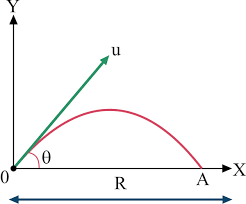
If a body is projected with a velocity of 9.8 \[m{s^{ - 1}}\] making an angle of \[{45^o}\]with the horizontal, then the range of the projectile is (take \[g{\text{ }} = {\text{ }}9.8{\text{ }}m{s^{ - 2}}\])
(A) 39.2 m
(B) 9.8 m
(C) 4.9 m
(D) 19.6 m
Answer
216.6k+ views
Hint: The range of the projectile is the max horizontal distance covered by the projectile. This is calculated using the expression relating the projectile velocity, acceleration due to gravity and angle of projection. Substitute the values in S.I units to find the range.
Complete step-by-step answer
For a projectile motion the horizontal distance traveled by a body during the time of flight is range. Assuming that the staring and the end point are at equal height, the range of the projectile (R) is given by

$R = \dfrac{{{u^2}\sin 2\theta }}{g}$
Where,
u is the velocity of the object
θ is the angle of projection
g is the acceleration due to gravity
The data given in the problem:
\[\begin{array}{*{20}{l}}
{u{\text{ }} = {\text{ }}9.8{\text{ }}m{s^{ - 1}}} \\
{g{\text{ }} = {\text{ }}9.8{\text{ }}m{s^{ - 2}}} \\
{\theta = {\text{ }}{{45}^0}}
\end{array}\]
Now substitute the known data in the range formula
$
R = \dfrac{{{{9.8}^2} \times \sin 90}}{{9.8}} \\
R = 9.8m \\
$
Hence, the range of the projectile is 9.8 m and the correct option is B
Note
1. Range of the projectile is max when it is projected with an angle of 45o.
Range of the projectile can also be expressed as
$R = \dfrac{{2{u_x}{u_y}}}{g}$
Where, $u_x$ and $u_y$ are the components of initial velocity.
2. In a general case: the starting and the end point of the projectile need not be at the same height.

Then this formula can be used
$R = \dfrac{{{v^2}}}{{2g}}\left( {1 + \sqrt {1 + \dfrac{{2gy}}{{2{{\sin }^2}\theta }}} } \right)$
Here R is the range, v is the launching velocity, g is the acceleration due to gravity, y is the difference in height between the starting and ending point from the ground, $\theta $ is the initial angle of launch
Complete step-by-step answer
For a projectile motion the horizontal distance traveled by a body during the time of flight is range. Assuming that the staring and the end point are at equal height, the range of the projectile (R) is given by

$R = \dfrac{{{u^2}\sin 2\theta }}{g}$
Where,
u is the velocity of the object
θ is the angle of projection
g is the acceleration due to gravity
The data given in the problem:
\[\begin{array}{*{20}{l}}
{u{\text{ }} = {\text{ }}9.8{\text{ }}m{s^{ - 1}}} \\
{g{\text{ }} = {\text{ }}9.8{\text{ }}m{s^{ - 2}}} \\
{\theta = {\text{ }}{{45}^0}}
\end{array}\]
Now substitute the known data in the range formula
$
R = \dfrac{{{{9.8}^2} \times \sin 90}}{{9.8}} \\
R = 9.8m \\
$
Hence, the range of the projectile is 9.8 m and the correct option is B
Note
1. Range of the projectile is max when it is projected with an angle of 45o.
Range of the projectile can also be expressed as
$R = \dfrac{{2{u_x}{u_y}}}{g}$
Where, $u_x$ and $u_y$ are the components of initial velocity.
2. In a general case: the starting and the end point of the projectile need not be at the same height.

Then this formula can be used
$R = \dfrac{{{v^2}}}{{2g}}\left( {1 + \sqrt {1 + \dfrac{{2gy}}{{2{{\sin }^2}\theta }}} } \right)$
Here R is the range, v is the launching velocity, g is the acceleration due to gravity, y is the difference in height between the starting and ending point from the ground, $\theta $ is the initial angle of launch
Recently Updated Pages
JEE Atomic Structure and Chemical Bonding important Concepts and Tips

JEE Amino Acids and Peptides Important Concepts and Tips for Exam Preparation

Electricity and Magnetism Explained: Key Concepts & Applications

Chemical Properties of Hydrogen - Important Concepts for JEE Exam Preparation

JEE Energetics Important Concepts and Tips for Exam Preparation

JEE Isolation, Preparation and Properties of Non-metals Important Concepts and Tips for Exam Preparation

Trending doubts
JEE Main 2026: Application Form Open, Exam Dates, Syllabus, Eligibility & Question Papers

Derivation of Equation of Trajectory Explained for Students

Hybridisation in Chemistry – Concept, Types & Applications

Understanding the Angle of Deviation in a Prism

Understanding Collisions: Types and Examples for Students

How to Convert a Galvanometer into an Ammeter or Voltmeter

Other Pages
JEE Advanced Marks vs Ranks 2025: Understanding Category-wise Qualifying Marks and Previous Year Cut-offs

Units And Measurements Class 11 Physics Chapter 1 CBSE Notes - 2025-26

NCERT Solutions For Class 11 Physics Chapter 8 Mechanical Properties Of Solids

Motion in a Straight Line Class 11 Physics Chapter 2 CBSE Notes - 2025-26

NCERT Solutions for Class 11 Physics Chapter 7 Gravitation 2025-26

Understanding Atomic Structure for Beginners




